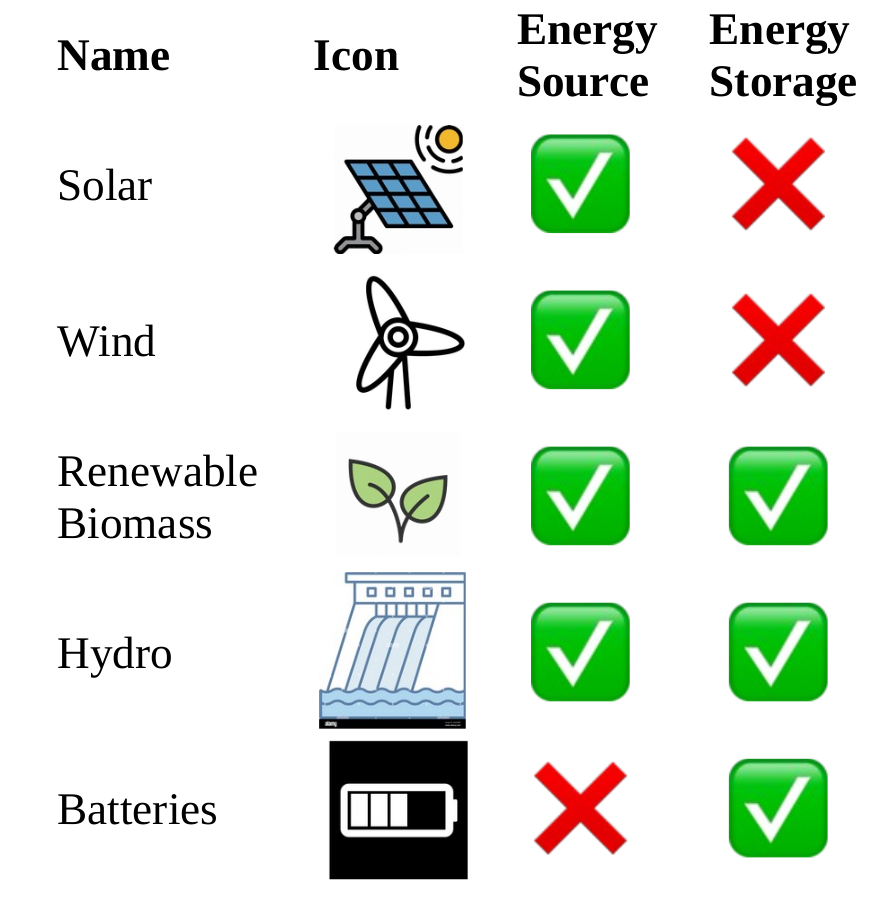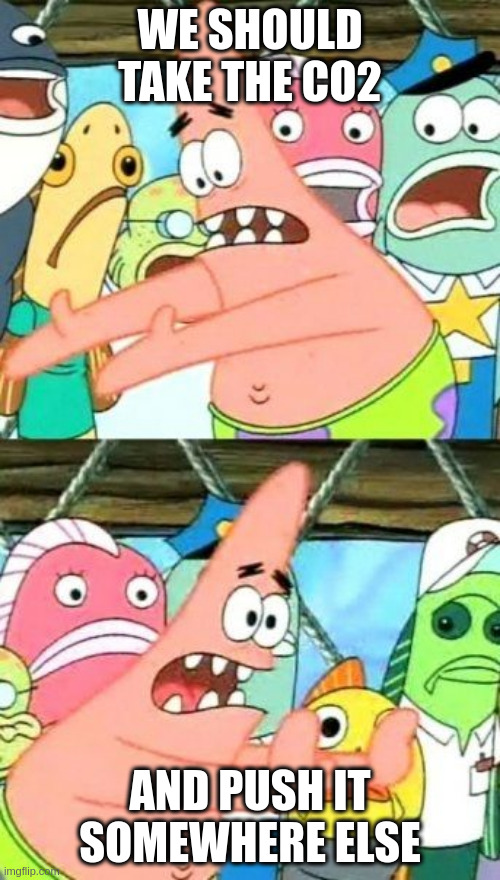I’ve heard there’s a practical green solution to carbon capture. The units are practically maintenance free and power themselves with solar energy. This allows to deploy them on many small patches of land. The captured carbon is stored in solid organic compounds that may be used as building materials. It may sound to sci-fi to be true, but it’s actually just trees.
Babe wake up, new copypasta just dropped !
Ok, but how about we do more than trees? Why are you on the internet when pre-linguistic grunting works just fine?
If you can find a more efficient, less expensive way to physically sequester carbon from the atmosphere than letting forests grow, I’m sure there’s a lot of awards you could win
Why does it have to be cheaper? Why not both?
Because if it isn’t cheaper than simply growing trees, the money would be better spent simply growing trees
And places trees don’t grow?
Try thinking for a second.
Places where trees don’t grow are probably not the best places for carbon sequestration if you can’t sequester carbon there cheaper or easier than sequestering carbon in trees elsewhere
The point of my comment is that if trees wouldn’t exist, they would seem like some futuristic sci-fi solution too good to be true. Just because something is shiny new tech, it isn’t automatically better. Sure, just planting trees won’t save us if we release all the carbon that is already captured in the form of fossil fuels, but how about we stop releasing all the carbon that is already captured in the form of fossil fuels?
Water is the biggest limiting factor, trees need more water.
Yeah, it’s different. I think the machine on the left is an infinite energy machine. Those will never work.
The machine on the right is a carbon capture machine which does work. But not well enough. Are fast enough to solve any of the problems that we have.
I’m fine with playing around with a carbon capture machine and seeing if we can improve it, but I would never want to rely solely on it.
I want to try a thousand solutions to the global warming problem. Including societal and government changes. Cuz you know otherwise we all die.
I mean, we already have carbon sequestration machines that are even self replicating, and require minimal, if any maitenance…
Trees and algae.
Most pollution comes from shipping, agriculture, and other large industries. Poor countries/people cannot contribute because they are barely getting by as is. Even if the entire middle class in wealthy countries magically switched to electric/public/bicycling, started recycling, stopped watering grass, etc. it would make no noticeable difference.
The idea that social changes at individual level can help with pollution comes directly from propaganda pushed by cunts who are actually killing our planet for profit. Fuck them. Don’t spread their lies.
I don’t. When I say social change I’m more talking about like social thinking that individuals are the problem. Sorry if that was not clear.
This is wrong, or perhaps I misundertand.
Entropy is a different concept from economic viability.
The rule of non-decreasing entropy applies to closed systems.
A carbon capture system running on solar energy on Earth (note: wind energy is converted solar energy) is not a closed system from the Earth perspective - its energy arrives from outside. It can decrease entropy on Earth. Whether it’s economically viable - totally different issue.
…and I don’t think the Sun gets any worse from us capturing some rays.
Also, I don’t think entropy has anything to do with carbon in the atmosphere. I thought it had to do with the size of the energy packets.
Its that using an extra step in the process (producing energy + CO2, then using energy to remove CO2) is going to increase entropy more than not producing CO2 in the first place.
Economic viability is separate and sometimes related to things like this.
Its irrelevant to the economy (in the short term at least) whether a process is efficient in terms of energy or resources. What is relevant is whether or not something can be done for either small sums of money, or sold for profits. More likely both in a capitalist style economy.
Note that it does happen in some cases that using less energy/resources is more profitable, but the driving force, again in a capitalist style economy, is the profit.
That small red bulb counteracts the entropy argument because you bring energy (and quite a lot of I recall) into the system.
Would be a sad day if we no longer could reduce entropy locally under the invest of energy.
Would be a sad day if we no longer could reduce entropy locally under the invest of energy.
I don’t think there’d be anyone left alive to be sad in that case…
That’s sad
The wider issue is you have to generate that energy, and you have to be able to capture more carbon than that generation released.
As I understand it doesn’t at all. This is why it’s seen as analagous to a perpetual motion machine, it’s an endless chain of power plants capturing each others carbon to no end.
You could use solar of course, but then why generate anything with fossil fuels just to capture the carbon with solar? Just use solar.
Because we still need to bring CO2 levels down even if we stop burning fossil fuel.
And then we’ll probably need to burn fossil fuel to keep them at the right level, since we are in a capitalistic society and we’re never going to be able to shutdown the CO2 collectors if they are ever built.
What I mean by entropy is that we burn fossil fuels (low entropy) and release CO2 into the atmosphere (high entropy), so it takes a lot more energy and effort to remove CO2 than simply not burning fossil fuels.
Clearly laws of physics work against us when we try to remove a relatively low concentration gas from a planet-wide system.
The point is to use a low carbon power source to power it.
Yes that’s the point but why take the extra steps. Use the low carbon energy directly and stop using the high carbon sources.
The argument is that there exist some use cases where we do not have a viable low carbon energy source yet (things like heavy farming equipment or aircraft), and one can effectively counteract the emissions of these things until we do develop one. Or alternatively, by the time that we eliminate all the high carbon energy, the heating effect already present may be well beyond what we desire the climate to be like, and returning it to a prior state would require not just not emitting carbon, but removing some of what is already there.
viable low carbon energy source yet
Not limited to energy sources either: steel production requires carbon as part of the alloy.
In the production of cement, calciumcarbonate gets heated and emits co2.
Both of these products can not be made without the emission of co2, even when using 100% solar and wind energy
I just literally can’t imagine a machine that is both cheaper and easier to deploy than the green goo we call life. Plant a tree. It’ll even spread itself. They look pretty.
Unfortunately, this is one area human imagination and intuition fail. Trees are great, but the math shows they simply aren’t remotely viable as a means of bulk carbon sequestration.
I think you have to cut them down and bury them (or at least don’t burn them) for the carbon to “go away”.
That’s how it got underground to begin with.
Still until we actually 100% switch everything we could power off solar and wind to solar and wind, active carbon capture doesn’t make sense, sense we could use that clean energy for direct purposes instead of cleanup. I’m not sure we will ever have “excess energy” like that, we will always rather use it for something other than cleaning up our mess, like AI.
yes, you are correct, it makes more sense to focus on electrifying our big consumers first.
however, cleaning up could happen eventually. maybe some politician in the future will sell it as some “jobs program” or sth.
They were for several hundred million years. What changed?
Nothing. You’re just asking trees to do something they’re not meant to do. Absorbing a single year of carbon emissions would require half the planet’s land area of trees. And that’s just while the trees are growing and absorbing a lot of carbon. Trees just aren’t efficient enough on a per acre basis to make a dent in carbon emissions, let alone capturing the carbon already in the atmosphere.
Trees never evolved for the purposes of mass capturing carbon from the air as efficiently as possible. Yes, they convert CO2 to O2 as part of their life cycle, but algae and other organisms have a much bigger role in capturing CO2 and turning it into O2.
Furthermore, so much of the CO2 that we emit is CO2 that was sequestered in the past over those very same 100s of millions of years. Meaning that going the natural route will take that amount of time.
What about sea weed? And sink it to the ocean floor?
Trees aren’t actually that great. Algee is what is really effective. Codyslab has some great videos and some wild ideas on application for it.
I was under the impression that’s just because of the relative surface area of the ocean vs arable land
not only that. algae are effectively plants without all the structural (wood) parts. that means, they consume less energy constructing bulky dead material, and put all of their energy towards the growth of the functional parts. that is why they can spread more rapidly and achieve a higher efficiency than plants.
I think the ideal argument is both. Have a grid that’s (at least vast majority) green, and work towards using said green energy to recapture some CO2
This guy gets it

Renewable energy has many parts. I have listed the 5 most important here.
As you can see, renewable biomass and hydropower are also part of renewable energy. That is because they have the advantage of being both power-sources and energy-storages. That means people will continue to use biomass and combust it in the long term.
Even if we went to zero emissions soon, we’d still want to decrease CO2 over time to reverse the effects of climate change. Capturing co2 is always going to be much more energy intensive than not emitting it in the first place, but sometimes you don’t have another choice.
Or you know, we could plant trees…the original carbon capture device.
Yeah, but then you need to cut them down and burry them so that decomposition doesn’t release the co2 again. And it takes a lot of land, which can be prohibitive on the scale we’ll need.
Another interesting option is fertilizing parts of the ocean for algie to grow. Cody’sLab has an interesting video on a possible way to do that with intentionally crashing astroids into the ocean. https://youtu.be/z7u_IqzkJzE https://youtu.be/2zQb_OitsaY/?t=13m40s
All of these, plus mechanical direct air carbon capture are methods of carbon capture. The right answer will likely be some mix of all of them.
that’s why I just throw all my used paper in the trash to be buried in landfills #doingmypart #onlykindajoking
You may be able to get away with stacking the cut trees in deserts, where the dryness may prevent bacterial action
Edit: I watched the Cody’s lab video. I’m now on team asteroid 2024 yr4. If it isn’t going to hit we ought to try to get it to hit the Southern Ocean, and if it will hit we should aim it
yeah, i guess the algae would also have a counter-effect to global warming.
however, one must be a bit more sensitive about it, as it’s a biological process and can mess with the biological world around it. consider: somewhen in the 1970s, a huge cargo ship full of fertilizer (ammonia) sank in the ocean and it lead to a huge algae-growth in the middle of the ocean.
it definitely took some CO2 out of the air, but these algae often also produce lots of toxins as a by-product (to keep predators away), so that lead to a massive fish-dying. which is not so wishable, either.
so anyway, i guess taking CO2 out of the air can happen, but it should happen slowly, such as to not strain the environment too much.
yup, turns out burning coal is us literally releasing carbon that was already captured and stored ages ago.
the picture on the right isn’t demonstrating an engine. They simply use renewable energy to power the fans that suck in the air.
Doesn’t change the fact that industrial carbon capture is a scam, and most of that captured CO2 is later released back into the environment to help extract oil from old wells.
https://www.aogr.com/magazine/sneak-peek-preview/carbon-capture-boosting-oil-recovery
Yes but no. The two actual uses of carbon capture is to remove the co2 from the air before it would happen naturally and the other is making fuel sustainable for retro or novelty vehicles. You dont have to stop selling gas cars if all the fuel they use is made with carbon capture. This makes the fuel more expensive but more sustainable. Once you have driven a 911 or skyline you will understand why someone would want to drive a gas car ;) Also, technically you are going from a higher energy fuel to lower energy so as long as you can do something with the co2 it abides by thermodynamics but the problems arise when you consider real world losses.
TLDR: carbon capture is a technology we should use after we stopped polluting to fix the earth.
Pointless. The gas should be used for things that actually need it like airlines.
Trains go choo choo. But yeah that as well. On long haul flights that cant be avoided that is an excellent use for carbon capture fuel.
Specifically it’s not trying to be an over unity machine. Energy is spent pushing air through the filter medium; energy is spent moving the filter to the CO2 extractor; energy is spent heating the filter (or whatever the extraction system is); energy is spent compressing or freezing CO2 for storage
Just wait until they figure out how much carbon is captured by planting a tree.
Until the tree dies and rots or burns
Specifically replanting all the forests we cut down during the age of sail is just capturing the carbon that was released when those sailing ships rotted
If we wanted to keep the carbon captured which we captured with plants, we would have to store those plants where they are safe from rot or burn them in a (not yet invented) carbon capturing furnace
It’s not just ships. Before and after ships forests were/are cleared for farming. Net carbon sequestration of almost any forest is likely to be better than cropland and pasture - more so the old forests with well developed fungi and worms and stuff that fix and recycle some of it, not so much the timber forestry but i sustect theyre better than farms still.
Steel ships did not really even slow deforestation much - globally. Though you could argue that the sail ships enabled Europeans to bring all their various shit to the Americas - so it is maybe linked to the farming thing.
https://ourworldindata.org/world-lost-one-third-forests . FYI This graph is a bit misleading because time is warped on the vertical.
We also drained and dried out wetlands and bogs which are quite good at trapping a high amount of rotting material, also to make farmland. I’m not sure if that is counted in those stats - that is possibly more of a European overpopulation thing than a global one anyway.
I dont see how it will stop unles people start eating less, or more efficiently (I guess swap a lot of cow for cereals).
I don’t think monocultures + fertilizer + pesticides is going to be all that sustainable at keeping high yields in the long run - but we shall see about that I guess. Gene techlogy does seem to create some advances.
Decomp still sequesters carbon… where do you think all the oil came from, to begin with?
Oil came from plants before there were bacteria that can digest wood
Lol, ok.
You need to read up a bit more… that is not how we got oil…
Right. So all we need to do is deposit the wood in anoxic water and bury it.
Where are we putting all this CO2?

Your beer/soda glass.
Once we get this tech shrunk down to the size of Nitrogen generators it’s going to revolutionize the industry.
I very much prefer CO2 in my drinks, some other carbon captures get you CO and I’ve heard that’s not as good as a drink carbonator
What is the name of the contraption on the left? Looks like a perperpetual motion machine but I’d like to learn more about it.
It’s sometimes called an overbalanced wheel, an early perpetual motion device. The idea is that there’s more weights on the right side than the left side, so the wheel will turn clockwise. The weights are on rods that fall to the right as the wheel turns, so there’s always going to be more weights on the right. So the wheel turns forever. Free power woohoo!
The reality is that the balls on the left are further away from the axle. Futher from the axle = greater torque. Surprise surprise it all cancels out and the wheel eventually comes to rest.
That’s essentially how many gases are made from mixtures, like notrogen or oxygen. Showing this as something new tells a lot about author’s uderstanding. Carbon capture is not about making entirely new tech, it’s optimization, and that’s where startups suck at everything except for getting and then wasting cash.
I don’t question the working principles of DAC, or as you mention separating gasses. It’s just that burning fossil fuels for energy would make no sense if you had to use most, if not all of that energy on DAC. And if you want to use low-carbon energy to power carbon capture, why not use it directly to replace fossil fuels? It seems to me that to reduce net emissions it’s most efficient not to emit it in the first place.
Because stationary energy generation is the easiest thing to decarbonize, while other sources are much more difficult. Also some carbon sources are so disperse to practically track down. You going to hunt down every person using a diesel generator in Subsaharan Africa, go to their rural villages, and take their generator from them? Maybe, or it might be easier to just set up one big nuclear powered DACC plant. Then you don’t have to deal with the practical and political nightmare of hunting down millions of low intensity carbon sources among the poorest people on the planet. Just let the poor village keep its diesel generator til they’re ready to switch to solar. You don’t have to go in and start taking stuff from poor people. There are lots of examples of this, low intensity sources that add up in aggregate but would be a political nightmare to try and stop. DACC shines for this.
But, as far as I remember, major contributor to carbon emissions are not poor villages, but jet sets and their factories in poor villages exploiting the work of poor villagers who have no say about their air quality lest they lose their jobs like they lost their means to sustain themselves from farming. Indeed, just not flying for fun and not selling the oil and coal that do not really belong to them would be so much more technological than trying to get grants for things they do not understand (and waste them traveling the world on planes telling everyone they should invest in it too only to then burn the rest in taxes used to support oilgascoal industry directly or not). When you show perpetum mobile here it is totally relevant - that’s how greenwashing works in terms of economy on every level, no matter what technology is being praised.
That’s why you power the thing with renewables. We have to switch to green energy; that’s a given. But the point of DAC is we’ve already so thoroughly fucked up the environment that we have to also go further and start cleaning up our mess. Just switching to all solar power generation and electric cars would eventually work, but it would take hundreds of years at least for atmospheric CO2 to go back to normal.
Cant you just feed the CO2 from the nearest coal power plant?
deleted by creator
And? You want to spend even more energy on capturing it from air first?
I really think we can capitalism our way out of a capitalism caused climate crisis who’s with me and rex tillerson
AI will develop a reaction to turn atmospheric CO2 into electricity and oxygen and then we’ll have nothing to worry about in our future except for the constant threat of combustion.
We have such technology already, it’s just too expensive
We already have that technology it just sucks. Look up plant microbial fuel cells
















